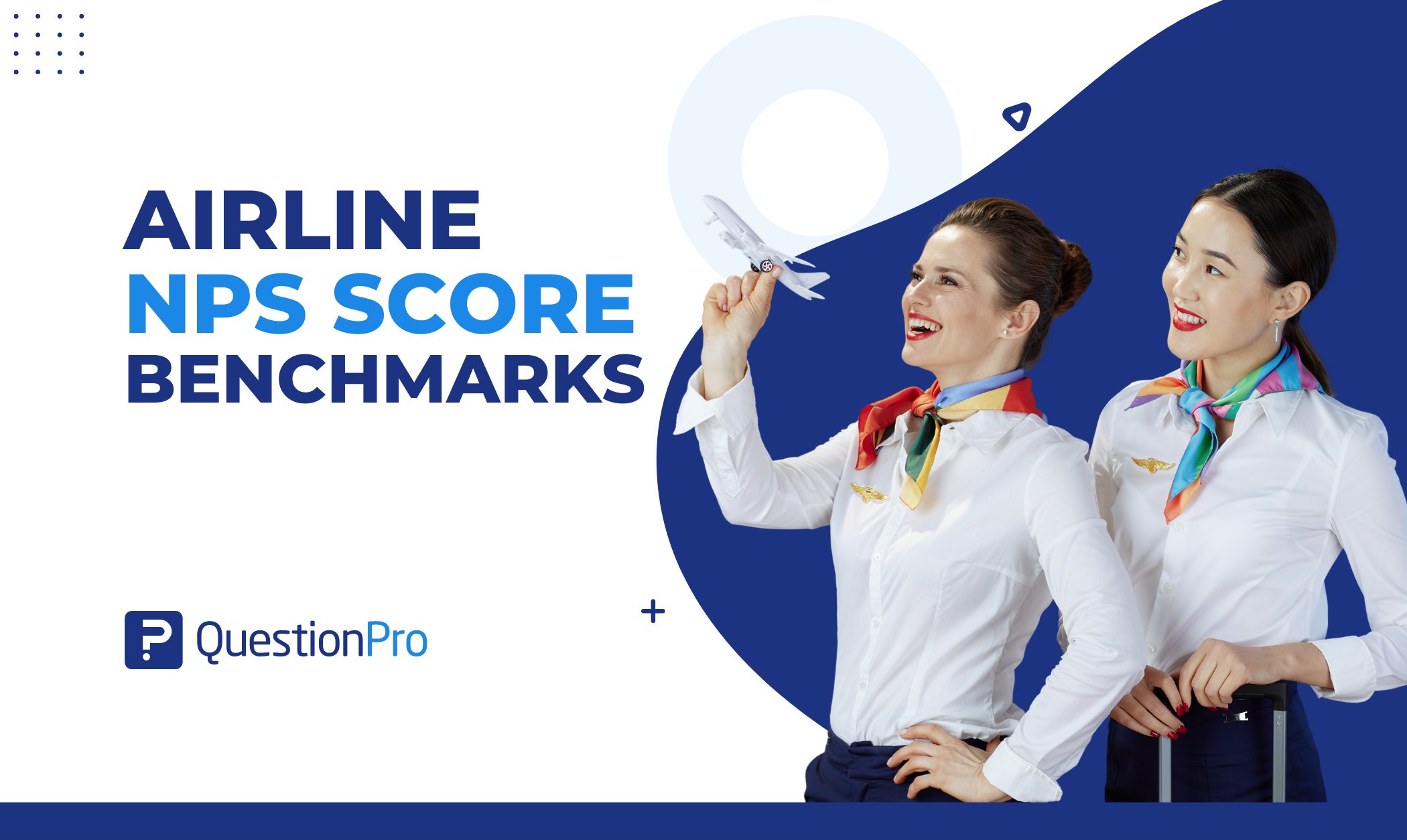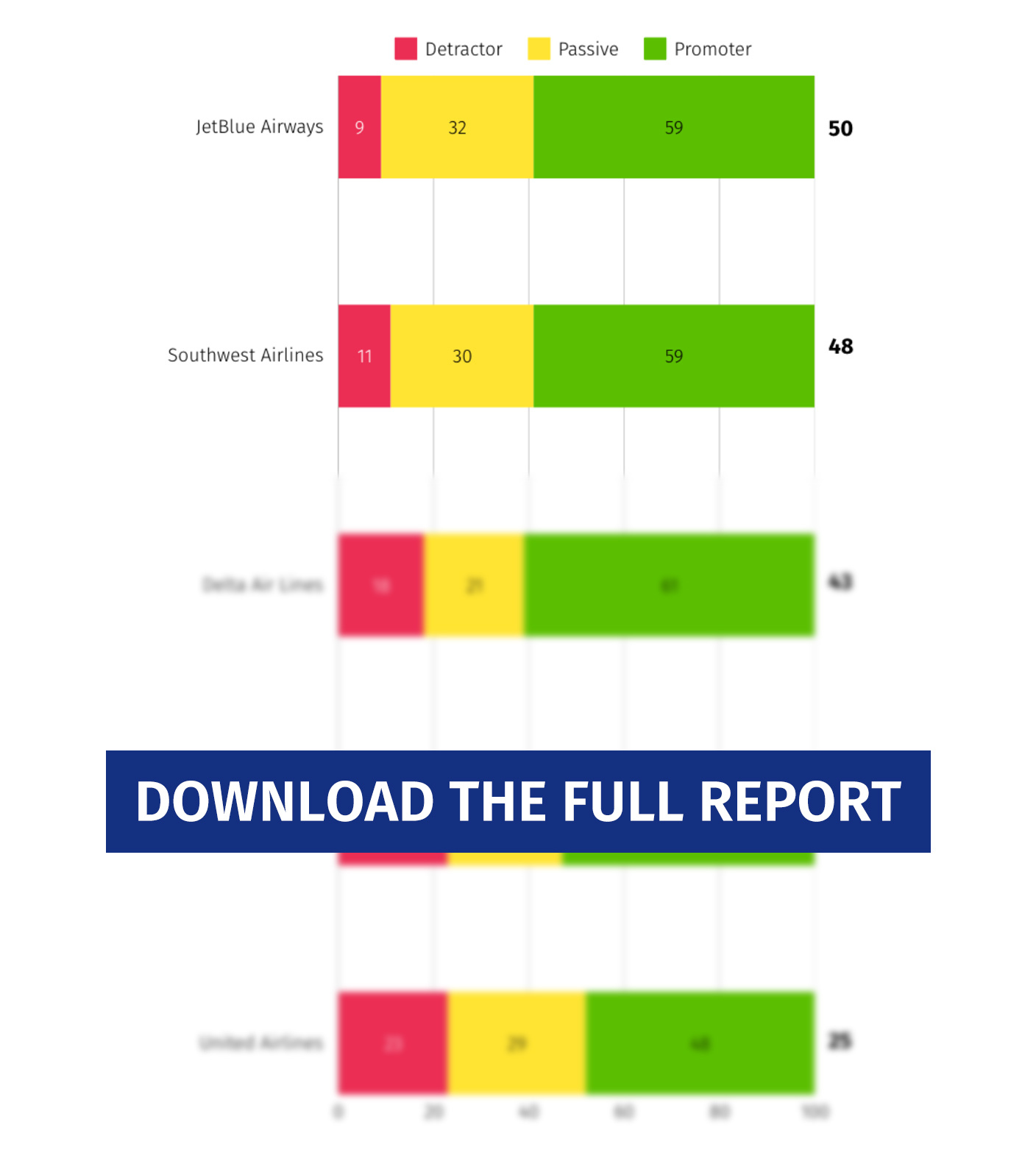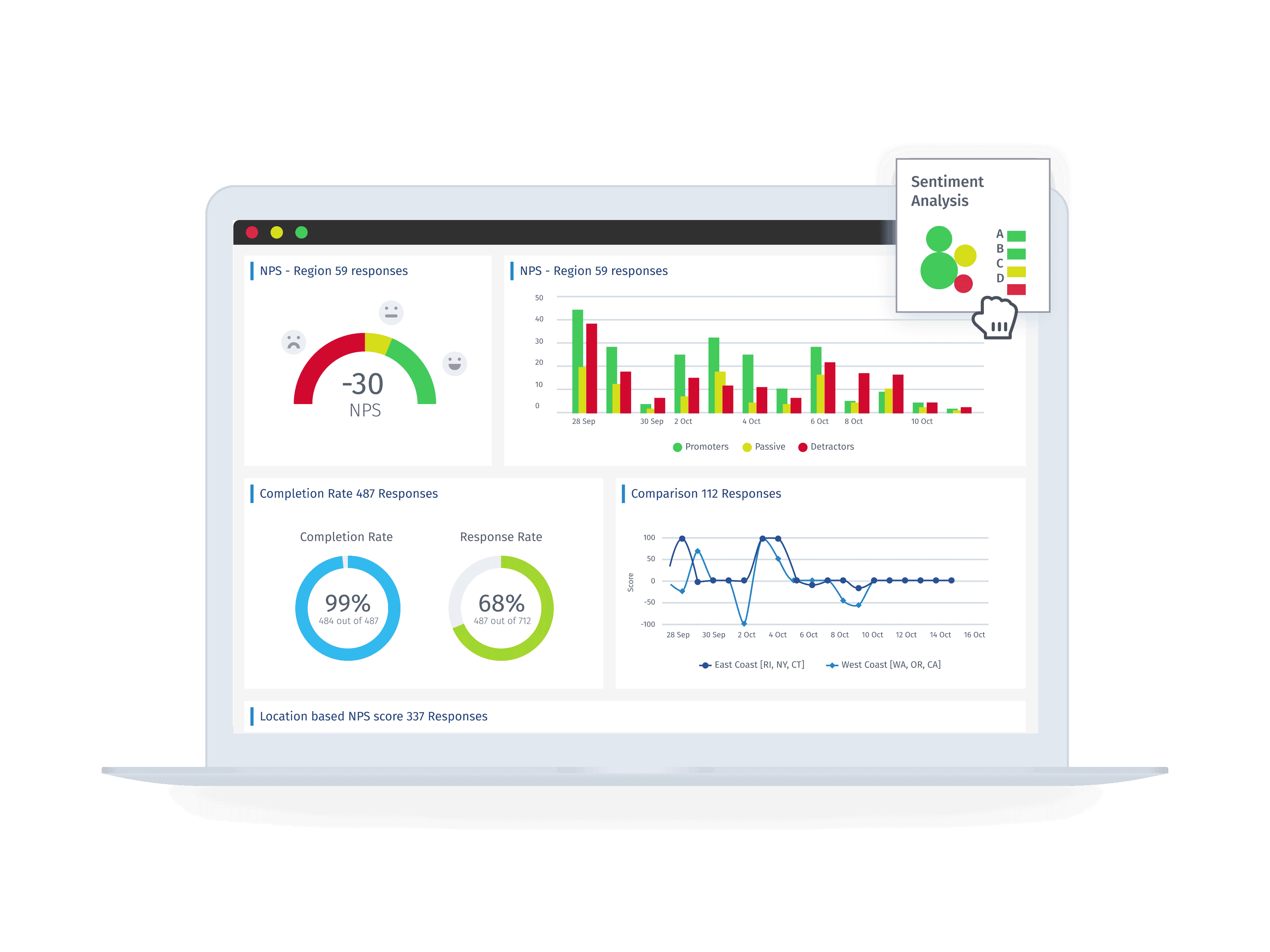
The airline industry operates in one of the most competitive and customer-sensitive environments in the world. With travelers increasingly prioritizing service quality, reliability, and convenience, understanding customer sentiment has become critical to airline success. One of the most effective tools for measuring that sentiment is the Net Promoter Score (NPS). Airline NPS Score Benchmarks provide valuable insights into how well carriers are meeting passenger expectations and where improvements are needed.
From check-in and boarding to in-flight service and baggage handling, each touchpoint influences customer loyalty, and NPS captures that feedback in a clear, actionable way.
In this report, we examine the latest Airline NPS Score Benchmarks for 2025, highlighting industry averages, top-performing carriers, and the key drivers of customer satisfaction. Whether you’re a CX strategist, airline executive, or frequent flyer, these insights can help you better understand the current landscape of airline loyalty and how it’s evolving.
What is Net Promoter Score?
Net Promoter Score, or NPS, is a simple way for businesses to find out how happy their customers are—and how likely they are to recommend the brand to others.
Think of it like this: after buying something or using a service, you might get a quick survey that asks:
“On a scale from 0 to 10, how likely are you to recommend us to a friend?”
That one question tells a lot. Based on your answer, you’re placed into one of three groups:
- Promoters (9 or 10): You’re really happy and would tell others to try it.
- Passives (7 or 8): You’re fine with it, but not excited enough to recommend it.
- Detractors (0 to 6): You’re not happy and might even warn others away.
To calculate your NPS:
% of Promoters – % of Detractors = NPS
To figure out the NPS, companies subtract the percentage of Detractors from the percentage of Promoters. The score can go from -100 (really bad) to +100 (amazing).
People trust recommendations. If lots of customers are willing to spread the word, it’s a sign the company is doing something right. If not, it shows there’s room for improvement.
NPS helps businesses understand how customers really feel—and what they can do to make things better.
How to Calculate NPS with the QuestionPro NPS Calculator
The QuestionPro NPS Calculator makes it easy to calculate your Net Promoter Score in just a few clicks. Whether you’re entering the number of promoters, passives, and detractors manually or using its built-in goal-setting feature, the tool instantly shows your NPS score, giving you a clear picture of customer loyalty.
But it doesn’t stop there. With QuestionPro, you can do more than just crunch numbers. The platform lets you gather real-time feedback through surveys at multiple customer touchpoints, track how your score changes over time, and take action based on what your customers are saying.
From email surveys to in-store kiosks, QuestionPro helps you collect, calculate, and improve your NPS—all from one easy-to-use platform.
What’s a Good NPS Score for the Airline Industry?
According to QuestionPro’s Q1 2025 Benchmarking NPS and CSAT Report, the airline industry earned an NPS of 33, placing it in the middle of the pack among the seven industries analyzed.

To understand how airlines compare, here’s a look at NPS scores across various industries from the same study:
- Hotel & Hospitality: 44 NPS
- Banking & Credit Unions: 41 NPS
- Automotive: 41 NPS
- Big Box Retail: 37 NPS
- Grocery Retail: 37 NPS
- Airlines: 33 NPS
- Insurance: 23 NPS
While the airline industry trails behind sectors like hospitality and banking, a score of 33 still reflects a fair level of customer satisfaction and brand loyalty. It suggests that passengers are generally pleased with their experience but that there’s still room to improve, especially in areas like service consistency, communication, and in-flight experience.
As travel demand grows and expectations rise, airlines that focus on enhancing customer experience can boost their NPS and stand out in a highly competitive space.
NPS Score Interpretation for Airlines
- Above 50: Excellent performance (exceptional passenger loyalty)
- 30–50: Good performance (strong traveler satisfaction)
- 0–30: Acceptable performance (inconsistent experiences, improvement needed)
- Below 0: Poor performance (critical issues affecting loyalty)
With an average NPS of 33, the airline industry falls into the “good performance” category. This suggests that many passengers are satisfied and willing to recommend their airline, but it also signals room for improvement. For airlines to move from “good” to “excellent,” the focus should be on delivering consistently smooth, customer-centric travel experiences across all touchpoints, from booking to baggage claim.
Airline NPS Benchmarks: Who’s Winning and Who’s Not
Our analysis highlights clear differences in NPS performance across major airlines, showing how service quality, pricing transparency, and in-flight experience directly impact passenger loyalty and satisfaction.
This benchmark focuses on some of the most recognized airline brands. If you believe an important carrier is missing, feel free to let us know.

These insights come from QuestionPro’s latest study, which surveyed 1,000 participants to measure NPS across leading companies and industries. The report is based on real customer feedback from Q1 2025 and is updated quarterly.
We invite you to download the full report. It’s a valuable resource for evaluating your company’s performance and determining your customers’ perceptions of you.
Key Performance Insights for the Airline Industry
The 25-point gap between the highest-performing airline (JetBlue at 50) and the lowest (United Airlines at 25) highlights the critical role of customer experience strategies in shaping passenger satisfaction and loyalty in the airline industry.
Passenger Sentiment Distribution:
- Detractors: Range from 10% (JetBlue) to 32% (United)
- Passives: Range from 22% (Southwest) to 36% (United)
- Promoters: Range from 42% (United) to 68% (JetBlue)
This variation reveals a clear pattern: airlines that invest in consistent service, transparent policies, and in-flight comfort tend to earn higher levels of customer advocacy. On the other hand, those with frequent delays, poor communication, or inconsistent service see a higher share of detractors—directly impacting their Net Promoter Score and long-term brand loyalty.
Discover What Major Brands are Doing to Achieve an Excellent NPS
Click here to access a detailed analysis of how the major Airline industries included in our study maintain customer satisfaction and how this has impacted their Net Promoter Score.
JetBlue Airways NPS
JetBlue tops the list with a strong NPS of 50, thanks to its passenger-friendly approach, generous legroom, free in-flight entertainment, and complimentary snacks. Its focus on comfort and customer service has built a loyal fanbase that’s eager to recommend the airline.
Delta Airlines NPS
Delta earns a solid NPS of 43, reflecting its commitment to on-time performance, reliable operations, and premium customer experiences. Its loyalty program, upgraded cabins, and consistently professional service contribute to strong customer satisfaction and brand trust.
Southwest Airlines NPS
Southwest continues to rank highly with an NPS of 48, driven by its transparent pricing, free checked bags, and friendly staff. Passengers value the airline’s hassle-free experience and flexible policies, making it one of the most trusted names in domestic air travel.
American Airlines NPS
American Airlines posts an NPS of 30, supported by its extensive route network, modernized fleet, and frequent flyer program. While it faces competition on service consistency, many passengers appreciate its broad destination coverage, premium cabin options, and ongoing investments in inflight technology.
United Airlines NPS
United Airlines records an NPS of 25, with strengths in global connectivity, upgraded lounges, and expanded premium seating options. While reviews on service can be mixed, its comprehensive international network and mileage program keep it a preferred choice for many long-haul travelers.
What Top Airlines Teach Us About NPS Success and Challenges
The wide range of Net Promoter Scores across airline brands reflects much more than just ticket prices or flight routes; it reveals how well airlines understand and respond to evolving passenger expectations.
Here are the key factors that set NPS leaders apart, and the common challenges airlines must overcome:
- Customer-Centric Service Culture: Airlines with high NPS scores, like JetBlue and Southwest, prioritize friendly, responsive, and human-centered service. From check-in to baggage claim, positive interactions and clear communication play a major role in building passenger loyalty.
- Transparent and Flexible Policies: Top-performing airlines are known for clear pricing, generous change or cancellation policies, and fewer surprise fees. This builds trust and reduces the friction that often turns travelers into detractors.
- Comfortable and Consistent In-Flight Experience: Airlines that offer extra legroom, free entertainment, quality snacks, and Wi-Fi tend to perform better. A comfortable flight—especially when combined with reliable on-time performance—directly drives promoter behavior.
Challenges and Lessons for Airlines
- Managing Operational Consistency at Scale: As airlines grow, maintaining high service standards across fleets and routes becomes harder. Delays, poor communication, or inconsistent staff behavior on just a few flights can negatively impact overall NPS.
- Rebuilding Trust After Disruptions: Weather, mechanical issues, or past service failures can erode passenger trust. Brands like United, which lag in NPS, often face a longer path to recovery—requiring better crisis response, transparency, and ongoing customer engagement.
- Technology That Enhances, Not Replaces, the Experience: While digital tools like mobile check-in, live flight updates, and automated support are now expected, airlines must ensure these tools are seamless and intuitive. Technology should make flying easier—not frustrate already stressed travelers.
In a competitive, high-stakes industry like aviation, customer experience is the true differentiator. The airlines with the highest NPS scores are those that combine operational reliability with empathy, value, and innovation—earning customer loyalty one flight at a time.
Take Flight with Better Passenger Loyalty: Start Tracking Your Airline’s NPS
In the airline business, loyalty isn’t just earned in the skies—it’s built at every step of the journey. From booking to baggage claim, understanding how passengers feel about their experience is essential. That’s where Net Promoter Score (NPS) comes in.
If you’re ready to improve customer satisfaction and stand out in a crowded market, here’s how to make NPS work for your airline:
1. Launch NPS Surveys at Key Touchpoints
Capture real feedback where it matters most—after booking, post-flight, or following customer service interactions. This gives you a clear view of how your passengers feel at different stages of their journey.
2. Compare Across Routes and Cabins
Not all passengers fly the same way. Analyze NPS by route, travel class, and frequent flyer status to uncover trends and spot friction points that may go unnoticed in broader metrics.
3. Use Feedback to Fine-Tune the Experience
Whether it’s long wait times, in-flight amenities, or the boarding process, your NPS data can help prioritize the areas passengers care most about—and where improvements will have the biggest impact.
Measuring and acting on NPS doesn’t have to be complicated. QuestionPro Customer Experience gives your airline the tools to:
- Collect meaningful insights automatically
- Visualize trends in real time across multiple customer journeys
- Identify loyalty gaps before they become costly problems

With QuestionPro Customer Experience, you can quickly measure your Net Promoter Score and set up ongoing monitoring systems to keep your travellers satisfied, helping you stay competitive and aligned with top performers in the airline industry.
Conclusion
With an average NPS of 33, the airline industry is doing a decent job when it comes to passenger satisfaction but there’s still plenty of room to improve. The gap between the top and bottom performers shows that not all airlines are meeting customer expectations in the same way.
The airlines that stand out are the ones that make flying feel easier, more comfortable, and more personal. Whether it’s helpful staff, fewer surprise fees, or simply getting passengers where they need to be on time, these details make a big difference. In a competitive space where travelers have more choices than ever, creating a smooth, reliable, and thoughtful experience is what earns long-term loyalty.







